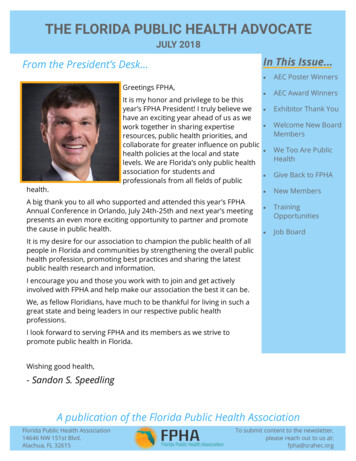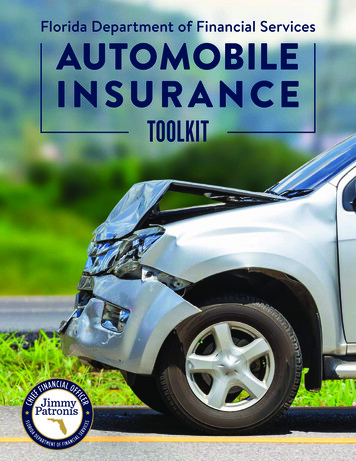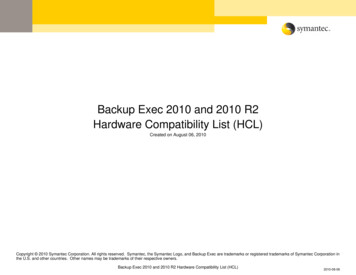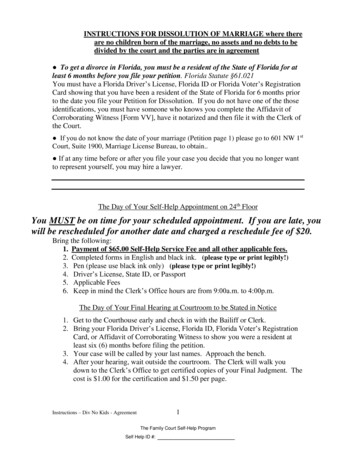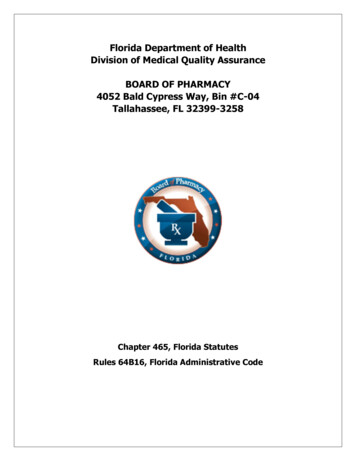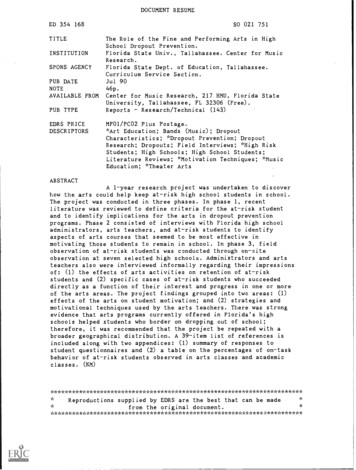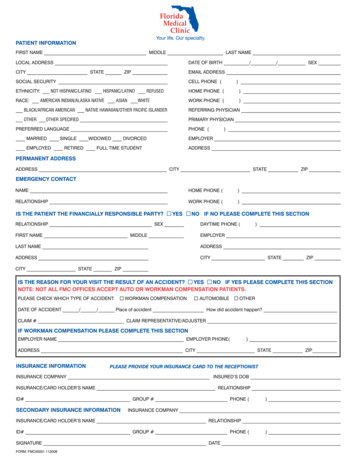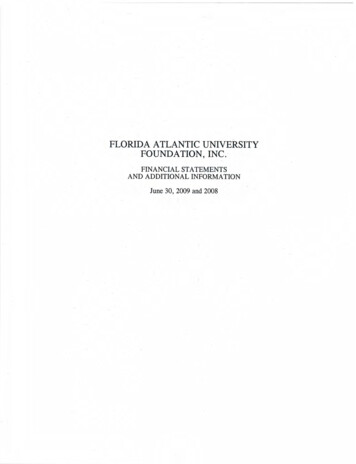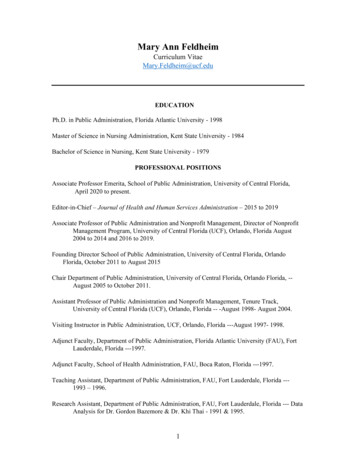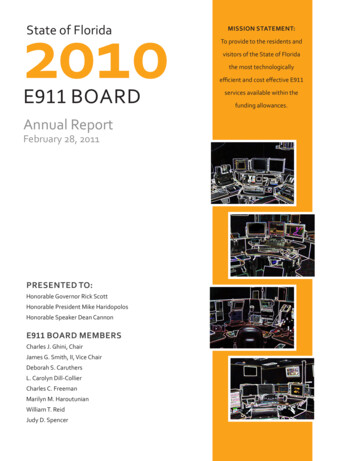
Transcription
2010state of floridaE911 BoardAnnual ReportFebruary 28, 2011Presented to:Honorable Governor Rick ScottHonorable President Mike HaridopolosHonorable Speaker Dean CannonE911 Board MembersCharles J. Ghini, ChairJames G. Smith, II, Vice ChairDeborah S. CaruthersL. Carolyn Dill-CollierCharles C. FreemanMarilyn M. HaroutunianWilliam T. ReidJudy D. SpencerMission Statement:To provide to the residents andvisitors of the State of Floridathe most technologicallyefficient and cost effective E911services available within thefunding allowances.
February 28, 2011The Honorable Rick Scott, GovernorOffice of the Governor400 South Monroe Street – PL05 – The CapitolTallahassee, Florida 32399-0001Dear Governor Scott:The State of Florida E911 Board respectfully submits its 2010 Annual Report. All counties currentlyreport operational Enhanced 911 (E911) systems, which provide lifesaving emergency 911 assistance.Florida is continuing Next Generation 911 (NG-911) migration, while working on the implementation ofnew E911 system accuracy requirements. The E911 Board continues to assist counties with E911system improvements and funding during this period of reduced E911 fee revenues. Highlights of someof the year’s accomplishments include:The E911 Board implemented a five-percent allocation change (increasing county disbursementsand reducing service provider cost recovery reserves), thereby increasing funding to the counties.The E911 Board approved a one-time special disbursement of 8 million from the EmergencyCommunications Number E911 System Fund (E911 Trust Fund), which was provided to assistthe counties with reduced E911 fee revenues and to help with funding for the mandatoryDepartment of Health (DOH) 911 public safety telecommunicators certification and training.The E911 Board developed rules on grant programs (rural county and state), service provider feeremittance requirements (including clarification for bundled Primary Rate Interface and T1circuits), and county carry-forward funding and excess recovery.The E911 Board provided an E911 State Grant Program as part of administering the E911 TrustFund to support counties in deploying new E911 and NG-911 systems.The E911 Board completed the challenges in implementing program modifications mandated by2010 statutory changes.The following items highlight the year’s financial activities: 123 million was collected from the E911 fee to support E911 in Florida.E911 fee revenues continued to decline in 2010, as revenues decreased 2.5 million, attributableto current economics, an increased prepaid wireless customer base, and related technologytrends.The E911 Board approved the disbursement of 122 million to help maintain, upgrade, andsupport operational E911 systems.Board Members:Deborah S. Caruthers L. Carolyn Dill-Collier Charles C. Freeman Charles J. GhiniMarilyn M. Haroutunian William T. Reid James G. Smith, II Judy D. Spencer
Florida E911 Board 2010 Annual ReportFebruary 28, 2011Page TwoThis is a challenging time for the E911 Board and counties, with the technology migration and currenteconomic and funding issues, to manage transition to Internet Protocol (IP) network-based E911systems. Momentum is escalating to provide the public with new 911 communications technologiesstatewide. The progression in E911 systems, called NG-911, is being designed to handle voice, data,and video over a standardized IP-based platform. Congress and Federal agencies are increasing effortsto regulate advanced technologies and NG-911 to ensure access to emergency services.E911 Board involvement is critical to development ofNG-911 statewide. The E911 Board's missionand primary goal is to provide the residents and visitors of the State of Florida with the mosttechnologically efficient and cost-effective E911 services within available funding allowances. Serviceprovider and regulatory issues must be addressed in the development of call routing and messageservices for NG-911.The focus of the 911 community in the coming years will be on NG-911 system migration andadditional training for 911 public safety telecommunicators. The ability to access emergency assistanceand the implementation of enhancements to the 911 systems within the State of Florida is largely due tothe efforts and continuing support of the Governor and the Florida Legislature.This report is respectfully submitted to you with the unanimous support of all eight (8) current membersof the State of Florida E911 Board. The E911 Board acknowledges the service and efforts of fourformer members that served on the 2010 E911 Board, including Sandi L. Chernoff, Andrew M. Feeney,John C. Ford, and Kim L. Paxton. By our signature below, the E911 Board reaffirms its dedication toprovide and improve Florida's Enhanced 911 systems.Sincerely, Y\ ames G. Smith, IIVice Chair eborah S. Caruthers j} l J yD. Spencer.
February 28, 2011The Honorable Mike Haridopolos, PresidentThe Florida Senate404 South Monroe Street – Suite 409 – The CapitolTallahassee, Florida 32399-1100Dear President Haridopolos:The State of Florida E911 Board respectfully submits its 2010 Annual Report. All counties currentlyreport operational Enhanced 911 (E911) systems, which provide lifesaving emergency 911 assistance.Florida is continuing Next Generation 911 (NG-911) migration, while working on the implementation ofnew E911 system accuracy requirements. The E911 Board continues to assist counties with E911system improvements and funding during this period of reduced E911 fee revenues. Highlights of someof the year’s accomplishments include:The E911 Board implemented a five-percent allocation change (increasing county disbursementsand reducing service provider cost recovery reserves), thereby increasing funding to the counties.The E911 Board approved a one-time special disbursement of 8 million from the EmergencyCommunications Number E911 System Fund (E911 Trust Fund), which was provided to assistthe counties with reduced E911 fee revenues and to help with funding for the mandatoryDepartment of Health (DOH) 911 public safety telecommunicators certification and training.The E911 Board developed rules on grant programs (rural county and state), service provider feeremittance requirements (including clarification for bundled Primary Rate Interface and T1circuits), and county carry-forward funding and excess recovery.The E911 Board provided an E911 State Grant Program as part of administering the E911 TrustFund to support counties in deploying new E911 and NG-911 systems.The E911 Board completed the challenges in implementing program modifications mandated by2010 statutory changes.The following items highlight the year’s financial activities: 123 million was collected from the E911 fee to support E911 in Florida.E911 fee revenues continued to decline in 2010, as revenues decreased 2.5 million, attributableto current economics, an increased prepaid wireless customer base, and related technologytrends.The E911 Board approved the disbursement of 122 million to help maintain, upgrade, andsupport operational E911 systems.Board Members:Deborah S. Caruthers L. Carolyn Dill-Collier Charles C. Freeman Charles J. GhiniMarilyn M. Haroutunian William T. Reid James G. Smith, II Judy D. Spencer
Florida E911 Board 2010 Annual ReportFebruary 28, 2011Page TwoThis is a challenging time for the E911 Board and counties, with the technology migration and currenteconomic and funding issues, to manage transition to Internet Protocol (IP) network-based E911systems. Momentum is escalating to provide the public with new 911 communications technologiesstatewide. The progression in E911 systems, called NG-911, is being designed to handle voice, data,and video over a standardized IP-based platform. Congress and Federal agencies are increasing effortsto regulate advanced technologies and NG-911 to ensure access to emergency services.E911 Board involvement is critical to development ofNG-911 statewide. The E911 Board's missionand primary goal is to provide the residents and visitors of the State of Florida with the mosttechnologically efficient and cost-effective E911 services within available funding allowances. Serviceprovider and regulatory issues must be addressed in the development of call routing and messageservices for NG-911.The focus of the 911 community in the coming years will be on NG-911 system migration andadditional training for 911 public safety telecommunicators. The ability to access emergency assistanceand the implementation of enhancements to the 911 systems within the State of Florida is largely due tothe efforts and continuing support of the Governor and the Florida Legislature.This report is respectfully submitted to you with the unanimous support of all eight (8) current membersof the State of Florida E911 Board. The E911 Board acknowledges the service and efforts of fourformer members that served on the 2010 E911 Board, including Sandi L. Chernoff, Andrew M. Feeney,John C. Ford, and Kim L. Paxton. By our signature below, the E911 Board reaffirms its dedication toprovide and improve Florida's Enhanced 911 systems.Sincerely,Q ames G. Smith, ITVice Chair Deborah S.aru ersarIes C. FreemanilhY4P ij Judy D. Spencer
February 28, 2011The Honorable Dean Cannon, SpeakerFlorida House of Representatives402 South Monroe Street – Suite 420 – The CapitolTallahassee, Florida 32399-1300Dear Speaker Cannon:The State of Florida E911 Board respectfully submits its 2010 Annual Report. All counties currentlyreport operational Enhanced 911 (E911) systems, which provide lifesaving emergency 911 assistance.Florida is continuing Next Generation 911 (NG-911) migration, while working on the implementation ofnew E911 system accuracy requirements. The E911 Board continues to assist counties with E911system improvements and funding during this period of reduced E911 fee revenues. Highlights of someof the year’s accomplishments include:The E911 Board implemented a five-percent allocation change (increasing county disbursementsand reducing service provider cost recovery reserves), thereby increasing funding to the counties.The E911 Board approved a one-time special disbursement of 8 million from the EmergencyCommunications Number E911 System Fund (E911 Trust Fund), which was provided to assistthe counties with reduced E911 fee revenues and to help with funding for the mandatoryDepartment of Health (DOH) 911 public safety telecommunicators certification and training.The E911 Board developed rules on grant programs (rural county and state), service provider feeremittance requirements (including clarification for bundled Primary Rate Interface and T1circuits), and county carry-forward funding and excess recovery.The E911 Board provided an E911 State Grant Program as part of administering the E911 TrustFund to support counties in deploying new E911 and NG-911 systems.The E911 Board completed the challenges in implementing program modifications mandated by2010 statutory changes.The following items highlight the year’s financial activities: 123 million was collected from the E911 fee to support E911 in Florida.E911 fee revenues continued to decline in 2010, as revenues decreased 2.5 million, attributableto current economics, an increased prepaid wireless customer base, and related technologytrends.The E911 Board approved the disbursement of 122 million to help maintain, upgrade, andsupport operational E911 systems.Board Members:Deborah S. Caruthers L. Carolyn Dill-Collier Charles C. Freeman Charles J. GhiniMarilyn M. Haroutunian William T. Reid James G. Smith, II Judy D. Spencer
Florida E911 Board 2010 Annual ReportFebruary 28,2011Page TwoThis is a challenging time for the E911 Board and counties, with the technology migration and currenteconomic and funding issues, to manage transition to Internet.Protocol (IP) network-based E911systems. Momentum is escalating to provide the public with new 911 communications technologiesstatewide. The progression in E911 systems, called NG-911, is being designed to handle voice, data,and video over a standardized IP-based platform. Congress and Federal agencies are increasing effortsto regulate advanced technologies and NG-911 to ensure access to emergency services.E911 Board involvement is critical to development ofNG-911 statewide. The E911 Board's missionand primary goal is to provide the residents and visitors of the State of Florida with the mosttechnologically efficient and cost-effective E911 services within available funding allowances. Serviceprovider and regulatory issues must be addressed in the development of call routing and messageservices for NG-91 1.The focus ofthe 911 community in the coming years will be on NG-911 system migration andadditional training for 911 public safety telecommunicators. The ability to access emergency assistanceand the implementation of enhancements to the 911 systems within the State of Florida is largely due tothe efforts and continuing support of the Governor and the Florida Legislature.This report is respectfully submitted to you with the unanimous support of all eight (8) current membersof the State of Florida E911 Board. The E911 Board acknowledges the service and efforts of fourformer members that served on the 2010 E911 Board, including Sandi L. Chernoff, Andrew M. Feeney,John C. Ford, and Kim L. Paxton. By our signature below, the E911 Board reaffirms its dedication toprovide and improve Florida's Enhanced 911 systems.Sincerely, am!c;'s Vice Chair 6r Deborah S. Carutherso 7 U00ares C. Freeman Ju yD. Spencer6
E911 Board 2010 Annual ReportTable of ContentsA.INTRODUCTION . 1B.EXECUTIVE SUMMARY . 21.2.3.4.SIGNIFICANT FINDINGS – CURRENT E911 STATUS . 3FINANCIAL HIGHLIGHTS . 4LEGISLATIVE CHANGE IMPLEMENTATION . 4LEGISLATIVE RECOMMENDATIONS . 5C.E911 BOARD, FEE, LEGISLATIVE INITIATIVES AND PROGRAM . 5D.E911 TRUST FUND RECEIPTS AND DISBURSEMENTS . 81.2.3.4.E.WIRELESS RECEIPTS FOR CALENDAR YEAR 2010 . 8NONWIRELESS RECEIPTS FOR CALENDAR YEAR 2010 . 8DISBURSEMENTS FOR CALENDAR YEAR 2010 . 9EMERGENCY COMMUNICATIONS NUMBER E911 SYSTEM FUND ASSETS AND BALANCE . 12STATUS OF ENHANCED 911 SERVICES . 131.2.3.4.PHASE I WIRELESS SERVICE . 13PHASE II WIRELESS SERVICE . 13IMPLEMENTATION ISSUES . 13NEXT GENERATION 911 . 14F.E911 STATE GRANT PROGRAM STATUS AND RECOMMENDATIONS . 14G.LONG TERM STRATEGIC INITIATIVES. 171.2.3.4.5.H.STATEWIDE E911 ROUTING . 17STATEWIDE E911 MAPPING . 17STATEWIDE E911 CALL TAKER E-TRAINING . 17REGIONAL ENHANCED 911 BACKUP PUBLIC SAFETY ANSWERING POINT. 17STATEWIDE E911 MANAGEMENT INFORMATION SYSTEM . 18ENHANCE 911 ACT GRANT PROJECT . 181.2.3.4.STATEWIDE E911 ROUTING . 18REGIONAL E911 MAPPING . 19STATEWIDE E911 CALL TAKER AND 911 PERSONNEL E-TRAINING . 19REGIONAL ENHANCED 911 BACKUP/TRAINING PUBLIC SAFETY ANSWERING POINT. 20I.DESCRIPTION OF E911 SERVICE DATA EVALUATION . 20J.RESULTS OF E911 SERVICE DATA EVALUATION . 211.2.3.4.5.6.7.K.COUNTY PROJECTION ANALYSIS . 21RURAL COUNTIES PROJECTION ANALYSIS . 22LOCAL EXCHANGE CARRIER SERVICE PROJECTION ANALYSIS . 23DECREASING NONWIRELESS REVENUES. 23WIRELESS SERVICE PROVIDER PROJECTION ANALYSIS . 25TOTAL COST (EXPENDITURE) AND FEE (REVENUE) ANALYSIS . 27E911 TRUST FUND BALANCE ANALYSIS . 29CONCLUSIONS . 301.2.3.E911 BOARD ADMINISTRATION OF PERCENTAGE ALLOCATION .
Marilyn M. Haroutunian William T. Reid James G. Smith, II Judy D. Spencer February 28, 2011 The Honorable Dean Cannon, Speaker Florida House of Representatives 402 South Monroe Street – Suite 420 – The Cap
